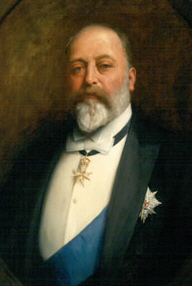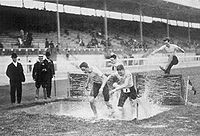Edwardian era
|
1901–1914
 King Edward VII, after whom the Edwardian period is named. |
|
| Preceded by | Victorian era |
|---|---|
| Followed by | World War I |
| Monarch | King Edward VII |
| Tudor Period | |
|---|---|
| Elizabethan Era | |
| Stuart Period | |
| Jacobean Era | |
| Caroline Era | |
| Georgian Era | |
| British Regency | |
| Victorian Era | |
| Edwardian Era | |
| Modern Britain | |
The Edwardian era or Edwardian period in the United Kingdom is the period covering the reign of King Edward VII, 1901 to 1910.
The death of Queen Victoria in January 1901 and the succession of her son, Edward, marked the start of a new century and the end of the Victorian era. While Victoria had shunned society, Edward was the leader of a fashionable elite which set a style influenced by the art and fashions of continental Europe—perhaps because of the King's fondness for travel. The era was marked by significant shifts in politics as sections of society which had been largely excluded from wielding power in the past, such as common labourers and women, became increasingly politicised.[1]
The Edwardian period is frequently extended beyond Edward's death in 1910 to include the years up to the sinking of the RMS Titanic in 1912, the start of World War I in 1914, the end of hostilities with Germany on November 11, 1918, or the signing of the Treaty of Versailles on June 28, 1919. By the end of the war, the Edwardian way of life, with its inherent imbalance of wealth and power, had become increasingly anachronistic in the eyes of a population who had suffered in the face of war and who were exposed to elements of a new mass media which decried the injustice of class division.
Contents |
Class and society
Socially, the Edwardian era was a period during which the British class system was very rigid. It is seen as the last period of the English country house. Economic and social changes created an environment in which there was more social mobility. Such changes included rising interest in socialism, attention to the plight of the poor and the status of women, including the issue of women's suffrage, together with increased economic opportunities as a result of rapid industrialization. These changes were to be hastened in the aftermath of the first World War.
The lower classes, as with earlier periods, were segregated from the aristocratic and mercantile "society", and led lives far removed from the relative luxury enjoyed by the other classes.
Fashion
The upper classes embraced leisure sports, which led to rapid developments in fashion, as more mobile and flexible clothing styles were needed. The very tight corset, or bodice, was modified, and later its everyday wearing was gradually abandoned.
The arts
The Edwardian period corresponds to the French Belle Époque period. Despite its short pre-eminence, the period is characterized by its own unique architectural style, fashion, and way of life. Art Nouveau held a particularly strong influence. Artists were influenced by the appearance of the automobile and electricity, and a greater awareness of human rights.
Literature
In fiction, some of the best-known names are J. M. Barrie, Arnold Bennett, Joseph Conrad, E. M. Forster, John Galsworthy, Kenneth Grahame, Edith Nesbit, Beatrix Potter, Lucy Maud Montgomery, H. G. Wells, and P. G. Wodehouse. Apart from these famous writers, this was a period when an enormous number of novels and short stories were being published and consumed, and a significant distinction between highbrow literature and popular fiction was emerging. Among the most famous works of literary criticism was A. C. Bradley's Shakespearean Tragedy (1904). Mass audience newspapers, controlled by press barons such as the Harmsworth brothers, Alfred Harmsworth, 1st Viscount Northcliffe and Harold Harmsworth, 1st Viscount Rothermere, became increasingly important.[2]
Music
The available recordings of music, such as wax cylinders played on phonographs, were poor in quality by modern standards. Live performances, both amateur and professional, were popular. Henry Wood, Edward Elgar, Gustav Holst, George Butterworth and Thomas Beecham were all active. Military brass bands often played outside in parks during the summer.[3]
Performing arts
Film was in its early days and audiences preferred live performances to picture shows. Music hall was very popular and widespread; influential performers included male impersonator Vesta Tilley and comic Little Tich.[4]
The theatre was marked by the rise of the New Drama, or plays by George Bernard Shaw, Harley Granville Barker, and Continental imports by Henrik Ibsen and Gerhardt Hauptmann. The actor/manager system, as headed by Sir Henry Irving, Sir George Alexander, and Sir Herbert Beerbohm Tree, was in decline.
Architecture
Notable architects included Edwin Lutyens, Charles Rennie Mackintosh and Giles Gilbert Scott. In spite of Art Nouveau raging on the European continent, the Edwardian Baroque style of architecture was widely favoured for public structures and was a revival of Christopher Wren–inspired designs of the late 17th and early 18th centuries. The change or reversal in taste from the Victorian eclectic styles corresponded with the historical revivals of the period, most prominently earlier Georgian and Neoclassical styles of the late 18th and early 19th centuries.
Science and technology
The turn of the century saw many great innovations. Continental Europeans, such as Max Planck, Albert Einstein, and Sigmund Freud were producing some of their greatest work. The first Nobel prizes were awarded, and Ernest Rutherford published his book on radioactivity. The first transatlantic wireless signals were sent by Guglielmo Marconi, and the Wright brothers took their first flight.
By the end of the era, Louis Blériot had crossed the English Channel by air, the largest ship in the world, RMS Olympic, had sailed on her maiden voyage, automobiles were common, and the South Pole was reached for the first time by Roald Amundsen's and then Robert Falcon Scott's teams.
Sport

The 1908 Summer Olympics were held in London. Popularity of sports tended to follow class divisions, with tennis and yachting popular amongst the very wealthy and football favoured by the poorest.
Politics and significant events
In the early years of the period, the Second Boer War in South Africa split the country into anti- and pro-war factions. Great orators, such as the liberal David Lloyd George who spoke against the war, became increasingly influential although pro-war politicians, such as Conservative Joseph Chamberlain, held power. The imperial policies of the Conservatives eventually proved unpopular and in the general election of 1906 the Liberals won a huge landslide. The Liberal government was unable to proceed with all of its radical programme without the support of the House of Lords, which was largely Conservative. Conflict between the two Houses of Parliament over the People's Budget led to a reduction in the power of the peers in 1910. The general election in January that year returned a hung parliament with the balance of power held by Labour and Irish Nationalist members.
Perceptions
The Edwardian period is sometimes imagined as a romantic golden age of long summer afternoons and garden parties, a perception created in the 1920s and later by those who remembered the Edwardian age with nostalgia, looking back to their childhoods across the abyss of the Great War.[5] The Edwardian age was also seen as a mediocre period of pleasure between the great achievements of the preceding Victorian age and the catastrophe of the following war.[6] Recent assessments emphasize the immense and real chasm between the wealthy and the poor during the Edwardian era and portray the age as heralding great changes in political and social life.[1] Robert Tressell's popular novel The Ragged Trousered Philanthropists is a strong example of the era's social critique.
Despite this, this type of perception has been challenged more recently by modern historians. The British historian Lawrence James has argued that during the early 20th century, Britain was instead mired in a "bout of intense national soul-searching", following a greater number of existential threats to Britain and her Empire, due to the rise of rival powers such as Germany, Russia and the United States.[7]
See also
References
- ↑ 1.0 1.1 Hattersley, Roy (2004). The Edwardians. London: Little, Brown. ISBN 0 316 72537 4.
- ↑ Priestley, pp.176–178
- ↑ Priestley, pp.132–139
- ↑ Priestley, p.172–176
- ↑ Priestley, pp.55–56 and 288–290
- ↑ Battiscombe, p.217
- ↑ James, Lawrence (1994). The Rise & Fall of the British Empire. Little, Brown and Company. ISBN 978-0-349-10667-0.
- Battiscombe, Georgina (1969). Queen Alexandra. London: Constable. ISBN 09-456560-0.
- Priestley, J. B. (1970). The Edwardians. London: Heinemann. ISBN 434 60332 5.
- Hattersley, Roy (2004). The Edwardians. London: Little, Brown. ISBN 0 316 72537 4.
- Tracy, Michael (2008). The World of the Edwardian Child. Hermitage. ISBN 978 2 96000755
External links
- The Edwardian Country House (Channel 4 TV series, very evocative of the period)
- Home Decor from the Edwardian Age (from the BBC)
- Edwardian Promenade (Website devoted to the Edwardian era)
- Edwardians by Paul Thompson (oral historian) at UK Data Archive
|
|||||||||||||||||||||||||||||||||||||||||||||||